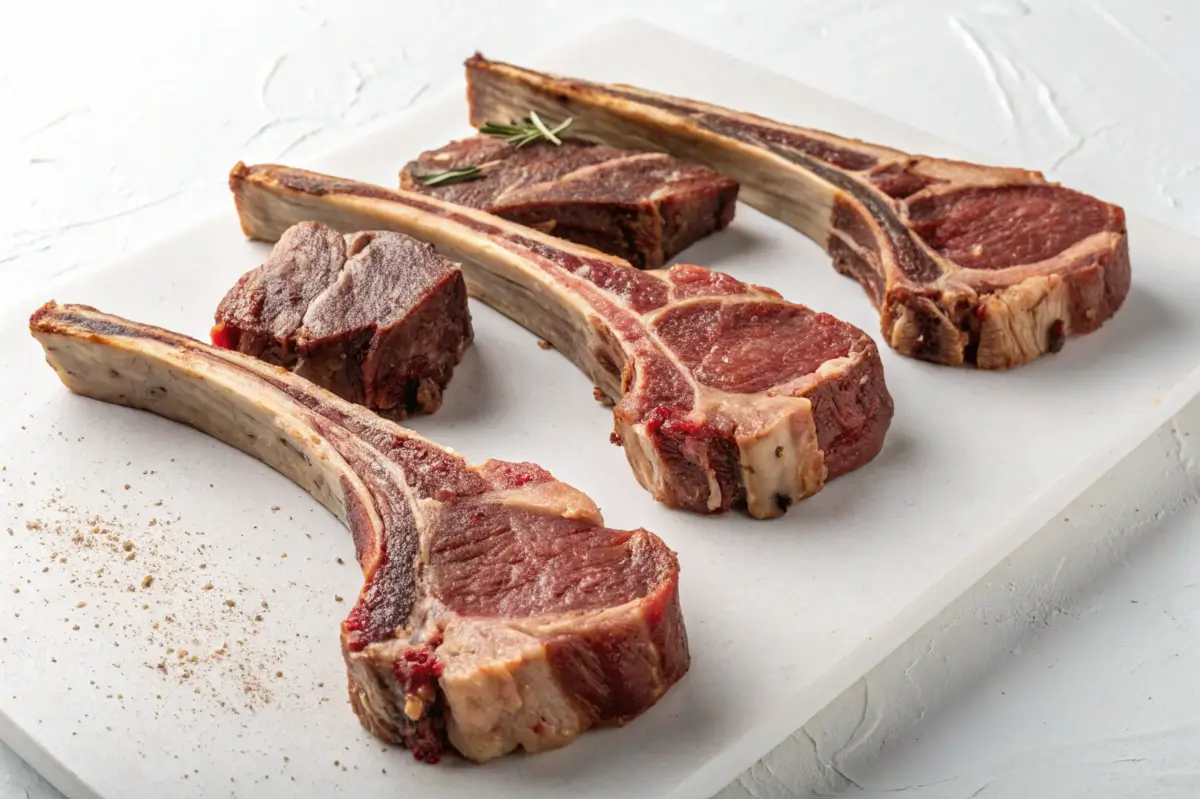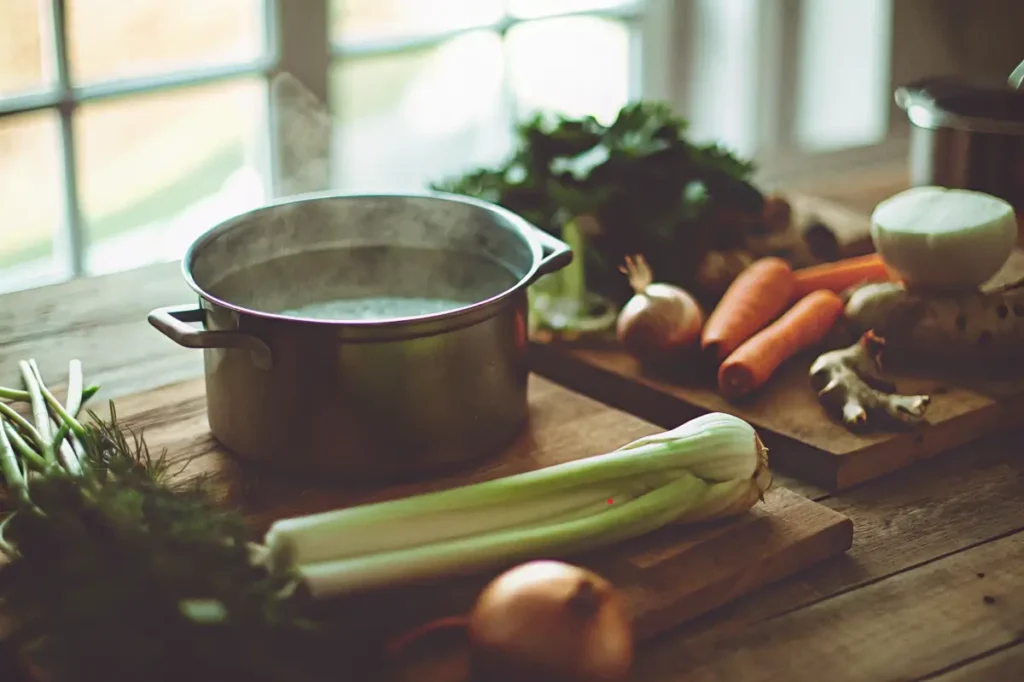Soup bones are a cornerstone of traditional cooking across various cultures, prized for their ability to enhance the flavor and nutritional value of dishes. Whether you’re crafting a hearty broth or a savory stew, soup bones are a key ingredient that transforms simple recipes into culinary masterpieces.
Definition and Overview of Soup Bones
A soup bone typically refers to the bones of animals, such as beef, pork, poultry, or fish, that are used to create flavorful broths and stocks. These bones often contain marrow, cartilage, and bits of meat, which release nutrients and rich flavors when simmered.
Historical Significance in Culinary Traditions
Soup bones have been used for centuries in cooking, from medieval kitchens in Europe to ancient Chinese herbal broths. Historically, they served as a way to minimize food waste while extracting maximum nutritional value from animals.
Cultural Variations and Uses
Across the world, soup bones play a pivotal role in regional cuisines:
- Asia: beef bones are often simmered with aromatics to create nourishing soups.
- Europe: Bones are the foundation of classic consommés and stocks.
- Africa: Bone-based broths are a staple in hearty stews.
Types of Soup Bones
Different types of soup bones contribute unique flavors and textures to dishes. Selecting the right bone can elevate your recipe.
Beef Bones
Beef bones are rich in marrow and collagen, making them a popular choice for broths.
- Marrow Bones: Packed with flavorful marrow, they create a creamy texture.
- Knuckle Bones: High in collagen, perfect for making gelatinous stocks.
- Oxtail: Contains both meat and bone, delivering robust flavor.
Poultry Bones
Poultry bones are lighter in flavor but still nutrient-rich.
- Chicken Feet: High in collagen, excellent for gut health.
- Turkey Necks: Adds a rich and smoky flavor.
Fish Bones
Fish bones are used for quick-cooking broths, ideal for soups and sauces.
- Heads: Impart a rich umami flavor.
- Frames: Perfect for clear fish soups.
Nutritional Benefits of Soup Bones
Soup bones are not just about flavor—they’re a nutritional powerhouse. Simmering bones releases vital nutrients into the broth, making it a highly beneficial addition to your diet.
Rich Source of Collagen and Gelatin
Collagen, a structural protein found in connective tissues, transforms into gelatin when cooked. This process gives bone broth its characteristic thickness and provides several health benefits:
- Improved Skin Elasticity: Collagen supports skin health, reducing wrinkles and promoting hydration.
- Joint Support: Gelatin helps lubricate joints, making it beneficial for arthritis sufferers.
Essential Minerals
Soup bones are a natural source of minerals such as:
- Calcium: Strengthens bones and teeth.
- Magnesium: Supports nerve and muscle function.
- Phosphorus: Essential for energy production.
Amino Acids for Overall Health
The slow cooking process releases amino acids like:
- Proline: Aids in skin and connective tissue repair.
- Glycine: Improves sleep and cognitive function.
- Glutamine: Supports gut health and intestinal healing.
Gut Health and Digestive Benefits
The gelatin in bone broth supports the intestinal lining, aiding in the prevention of leaky gut syndrome. It also promotes the growth of healthy gut bacteria.
Anti-Inflammatory Properties
Certain compounds, such as glycosaminoglycans, reduce inflammation, making soup bones beneficial for people with chronic inflammatory conditions.
 Selecting Quality Soup Bones
Selecting Quality Soup Bones
Not all soup bones are created equal. Choosing high-quality bones ensures better flavor, nutrition, and ethical considerations.
Importance of Sourcing from Grass-Fed and Pasture-Raised Animals
Grass-fed and pasture-raised animals provide bones with a superior nutrient profile:
- Higher levels of omega-3 fatty acids.
- No exposure to antibiotics or hormones.
Organic vs. Conventional Bones
Opt for organic bones to minimize exposure to pesticides and harmful chemicals.
Identifying Freshness and Quality Indicators
Look for:
- Color: Fresh bones should appear white to light beige.
- Smell: Avoid bones with an off-putting odor.
- Texture: Choose bones with intact cartilage and marrow.
Sustainable and Ethical Considerations
Support local butchers and sustainable farms to reduce environmental impact and ensure humane animal treatment.
Preparing Soup Bones for Cooking
Proper preparation is essential for extracting the maximum flavor and nutrients from soup bones.
Cleaning and Blanching Techniques
Rinse bones under cold water to remove impurities.
- Blanch by boiling for 5–10 minutes, then discard the water.
Roasting for Enhanced Flavor
Roasting bones at 400°F (200°C) caramelizes the surface, deepening their flavor. This step is particularly important for beef and pork bones.
Utilizing Aromatics and Vegetables
Enhance the flavor by adding:
- Aromatics: Garlic, onion, ginger.
- Vegetables: Carrots, celery, leeks.
Appropriate Cooking Vessels and Equipment
- Stockpot: For large batches.
- Slow Cooker: Ideal for hands-off cooking.
- Pressure Cooker: Quickens the process without compromising flavor.
Cooking Methods for Soup Bones
Cooking soup bones requires patience and the right techniques to unlock their full flavor and nutritional benefits. Here are some popular methods:
Simmering on the Stovetop
Simmering is the traditional method for cooking soup bones.
- Process: Combine the bones, water, and aromatics in a large stockpot. Bring to a boil, then reduce to a gentle simmer.
- Duration: Beef or pork bones may take 12–24 hours, while poultry bones take 6–12 hours.
- Tip: Skim off impurities periodically for a clear broth.
Slow Cooker Techniques
Using a slow cooker is a convenient, hands-off method:
- Process: Place bones, water, and seasonings in the slow cooker. Cook on low for 8–12 hours or overnight.
- Advantages: Low heat preserves nutrients and extracts gelatin effectively.
Pressure Cooking for Efficiency
Pressure cookers speed up the process without compromising quality:
- Process: Add bones and water to the cooker. Cook on high pressure for 2–3 hours.
- Result: Rich and flavorful broth in a fraction of the time.
Traditional vs. Modern Approaches
- Traditional Methods: Rely on slow, prolonged simmering for maximum flavor extraction.
- Modern Methods: Utilize appliances like pressure cookers for convenience.
 Recipes Featuring Soup Bones
Recipes Featuring Soup Bones
Soup bones are the foundation for a variety of hearty and nourishing recipes. Here are some popular dishes to try:
Classic Beef Bone Broth
This nutrient-rich broth is a staple in many kitchens.
- Ingredients: Beef marrow bones, onion, carrot, celery, garlic, water, bay leaves, and peppercorns.
- Instructions:
- Roast the bones for 30 minutes at 400°F (200°C).
- Simmer with vegetables and aromatics for 12–24 hours.
- Strain and season to taste.
Hearty Vegetable Beef Soup
Perfect for a cold day, this soup is both filling and nutritious.
- Ingredients: Beef knuckle bones, diced vegetables (carrots, potatoes, celery), crushed tomatoes, and herbs.
- Instructions:
- Make a base broth using the soup bones.
- Add vegetables and simmer until tender.
- Season with salt, pepper, and fresh parsley.
Chicken Foot Broth
A collagen-packed broth perfect for gut health.
- Ingredients: Chicken feet, onion, garlic, apple cider vinegar, and water.
- Instructions:
- Blanch the chicken feet, then simmer with aromatics for 8–10 hours.
- Strain and serve.
Fish Head Soup
A quick and nutrient-dense option for seafood lovers.
- Ingredients: Fish heads, ginger, garlic, tomatoes, and herbs.
- Instructions:
- Simmer fish heads with aromatics for 30–45 minutes.
- Add tomatoes and herbs for a flavorful finish.
Storing and Preserving Bone Broth
Proper storage ensures the longevity and safety of your homemade bone broth.
Refrigeration Guidelines
- Cool the broth to room temperature, then transfer to airtight containers.
- Store in the refrigerator for up to 5 days.
Freezing Techniques
- Freeze in portion-sized containers or ice cube trays for convenience.
- Properly stored, bone broth can last up to 6 months in the freezer.
Shelf Life and Safety Considerations
- Check for any off-putting smells or discoloration before use.
- Boil previously stored broth for at least 10 minutes to ensure safety.
Culinary Applications of Bone Broth
Bone broth is not just for sipping—it has a wide range of uses in the kitchen, making it a versatile ingredient for enhancing flavors and boosting nutrition.
Base for Soups and Stews
Bone broth serves as a flavorful and nutritious foundation for soups and stews, such as:
- Chicken noodle soup
- Beef and barley stew
- Lentil soup
Cooking Grains and Legumes
Substitute water with bone broth to infuse your grains and legumes with additional flavor and nutrients:
- Use it to cook rice, quinoa, or barley.
- Soak and cook beans or lentils in bone broth for a heartier taste.
Enhancing Sauces and Gravies
Bone broth adds depth to sauces and gravies, enriching their flavor profile:
- Deglaze pans with bone broth for a quick sauce.
- Use it as the base for creamy gravies or reductions.
As a Nutritious Beverage
Bone broth is a popular standalone beverage, especially for health enthusiasts. It’s commonly consumed:
- Warmed with a pinch of salt and pepper.
- Enhanced with fresh herbs like parsley or cilantro.
Addressing Common Concerns and Misconceptions
Despite its growing popularity, bone broth has its share of myths and misconceptions. Let’s clarify some common concerns:
Clarifying Health Claims
While bone broth offers numerous health benefits, it’s not a miracle cure. Pairing it with a balanced diet is essential for optimal health.
Debunking Myths About Bone Broth
- Myth: Bone broth is calorie-free.
Fact: It contains calories from proteins and fats, albeit minimal. - Myth: Bone broth detoxifies the body.
Fact: The liver and kidneys handle detoxification, though broth can support overall health.
Understanding Dietary Considerations
Bone broth can be adapted to various dietary needs:
- Low-Sodium Diets: Limit added salt or use low-sodium bones.
- Keto-Friendly: Bone broth is naturally low in carbohydrates, making it suitable for ketogenic diets.
Frequently Asked Questions (FAQs)
Here are answers to some of the most common questions about soup bones:
What is a soup bone?
A soup bone refers to the bone of an animal—such as beef, pork, poultry, or fish—used in cooking to create broths and stocks. They are rich in nutrients, collagen, and flavor, making them essential for hearty soups and stews.
What is a soup bone slang?
In slang, “soup bone” can refer to a strong punch in boxing or sometimes to a humorous reference to a large hand or fist. more
Can I eat the meat from soup bones?
Yes, the meat from soup bones is edible and often flavorful. It’s especially tender after being simmered in broth, though its texture might be softer than traditional cuts. more
What is the best bone for soup?
The best bone depends on your recipe:
- For beef broth, marrow bones or knuckle bones are ideal.
- For lighter broths, poultry bones like chicken feet or turkey necks work well.
- For seafood dishes, fish heads and frames are perfect. more
Advanced Tips for Working with Soup Bones
To elevate your soup-making skills, consider these expert tips:
Adding Acid for Nutrient Extraction
Acids like vinegar or lemon juice help break down the collagen in bones, increasing the gelatin content of your broth. Add a tablespoon of apple cider vinegar during the simmering process.
Timing Matters
- Short Cooking Time: For fish bones, limit the cooking time to avoid a bitter taste.
- Long Cooking Time: For beef and pork bones, a longer simmer extracts maximum nutrients and flavor.
Layering Flavors
Adding ingredients at different stages of cooking ensures a balanced flavor:
- Start with aromatics like onion, garlic, and celery.
- Add herbs like thyme, bay leaves, or parsley stems midway through.
- Finish with salt and pepper at the end to taste.
Straining for Clarity
To achieve a clear broth:
- Use a fine mesh strainer or cheesecloth to remove solids.
- Avoid vigorous boiling, which can emulsify fats and cloud the broth.
Environmental Impact and Sustainability
Using soup bones contributes to reducing food waste and promotes sustainable cooking practices. By utilizing parts of the animal that might otherwise be discarded, you can make a positive environmental impact.
Sourcing Locally
Buy bones from local farmers or butchers who prioritize ethical farming practices. This reduces carbon footprints associated with long-distance shipping.
Upcycling Leftovers
- Save vegetable scraps like carrot tops or onion skins to use in broth.
- Repurpose cooked bones into compost after they’ve served their culinary purpose.
Supporting Regenerative Agriculture
Choose suppliers who practice regenerative agriculture, which restores soil health and enhances biodiversity.
Innovative Soup Bone Uses
Soup bones are not just for broths—explore creative ways to incorporate them into your cooking.
Bone-In Roasts
Cook meats with the bone intact for added flavor and moisture retention.
Enriching Gravy and Sauces
Simmer bones with wine and herbs to create a concentrated stock for sauces.
Pet Treats
After the bones have been cooked, they can be given to pets as treats. Ensure they are soft enough to avoid splintering.
Cultural Significance of Soup Bones Across the Globe
Soup bones have been a vital part of cuisines worldwide, carrying deep cultural and historical significance. Here’s how different regions have embraced them:
Asia
- Korea: Pork and beef bones are used to make Seolleongtang, a milky, nutrient-rich broth simmered for hours.
- China: Bone broth forms the base for medicinal soups infused with herbs like ginseng and goji berries.
- Vietnam: The iconic Pho broth relies on beef bones for its signature flavor.
Europe
- France: Soup bones are foundational in classic French cuisine, especially for bouillon and consommé.
- Italy: Osso buco, a slow-cooked veal shank dish, uses marrow bones as the centerpiece.
- Germany: Knochenbrühe, a traditional bone broth, is consumed for its warming and healing properties.
Africa
- In many African countries, bones are used to create rich stews and soups that are staples in communal meals.
- The use of goat or lamb bones is common in North and East African cuisines, often paired with spices like cumin and coriander.
Americas
- United States: Bone broth has gained popularity in health-conscious circles for its wellness benefits.
- Mexico: Caldo de Res, a beef soup made with marrow bones and vegetables, is a comforting classic.
Scientific Research on Soup Bones and Broth
The benefits of soup bones go beyond old traditions—modern science supports their value. Here’s what the research says:
Collagen for Healthy Joints
Bone broth contains collagen, a protein that helps protect joints and keeps them flexible. Studies show that it can ease joint pain and support cartilage health, which is especially useful for older adults and athletes.
Gelatin for Better Digestion and Immunity
When collagen is cooked, it turns into gelatin. This gelatin helps the gut work better by protecting the lining of the stomach and intestines. A healthy gut means a stronger immune system, so you’re less likely to get sick.
Minerals Your Body Can Use Easily
Bone broth is full of important minerals like calcium and magnesium. These are in a form that your body can absorb quickly, making it a good way to add nutrients to your diet—especially if you’re not getting enough from food alone.
Fixing Common Problems When Making Bone Broth
Making bone broth isn’t always perfect, but here are some simple ways to fix common mistakes:
Cloudy Broth
- Why it happens: Boiling the broth too hard or too fast.
- How to fix it: Keep the heat low and gently simmer the broth. Skim off foam or bits that float to the top.
Weak or Bland Flavor
- Why it happens: Not roasting the bones or not using enough seasoning.
- How to fix it: Roast bones before cooking and add herbs, spices, and salt while it simmers.
Too Greasy
- Why it happens: The fat isn’t removed.
- How to fix it: After the broth cools, skim off the hard layer of fat from the top.
Bad Smell
- Why it happens: Using old bones or cooking too long.
- How to fix it: Use fresh bones and stick to the recommended cooking times.
New Ways People Are Using Soup Bones
Soup bones are becoming popular again, especially with people who care about their health and the planet. Here’s how they’re used today:
Easy-to-Use Broth Powders
Bone broth is now sold as powders or capsules. These are convenient and still provide a good source of protein, collagen, and minerals.
Bone Broth Cafés and Drink Bars
Many shops now serve bone broth as a warm, healthy drink. They often mix it with spices, herbs, or even things like turmeric or matcha for extra flavor and health benefits.
Perfect for Low-Carb Diets
Bone broth is naturally low in carbs, making it a favorite for people on keto or paleo diets. It’s also filling and helps curb hunger.
Better for the Environment
Using soup bones helps reduce food waste and supports eco-friendly cooking. Instead of throwing away bones, you turn them into something useful and healthy.
Final Thoughts
Soup bones aren’t just leftovers—they’re a secret weapon in the kitchen. They bring deep flavor, important nutrients, and help support a more sustainable way of cooking. Whether you’re sipping a warm cup of broth or making a rich stew, soup bones make your meals better in every way.


 Selecting Quality Soup Bones
Selecting Quality Soup Bones Recipes Featuring Soup Bones
Recipes Featuring Soup Bones